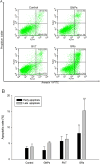Gold nanoparticle resveratrol complex increases apoptosis in KRAS mutant pancreatic cancer cells
- PMID: 40258879
- PMCID: PMC12012166
- DOI: 10.1038/s41598-025-98124-7
Gold nanoparticle resveratrol complex increases apoptosis in KRAS mutant pancreatic cancer cells
Abstract
The KRAS G12D mutation is the most prevalent type of pancreatic cancer and is found in about 35% of patients. Numerous natural chemicals are frequently investigated in cancer treatment to decrease side effects. Resveratrol (RVT) is a polyphenol that can promote cancer cell apoptosis and improve chemotherapy efficacy in cancers. To enhance delivery rate and efficacy, the size of about 30 nm gold nanoparticles (GNPs) was synthesized and conjugated to resveratrol via polyvinylpyrrolidone (GRs) for high bioavailability. Compared to RVT and GNPs, GRs had less inflammatory response and less toxicity on RAW 264.7 cells. This suggests that the toxicity of resveratrol can be alleviated by conjugation with gold nanoparticles. The viability of the human pancreatic cancer cell line (AsPC-1) decreased in sequence of GRs > RVT > GNPs, suggesting an enhanced anticancer effect of the GRs compared to resveratrol (RVT) alone. In addition, the extent of apoptosis was much bigger with GRs compared to RVT and GNPs. The apoptotic effects were confirmed with cell cycle arrest and expression of apoptosis-related genes and proteins. Thus, GRs had a better extent of anticancer effect than RVT, suggesting that GRs be considered as one of the prospective anti-cancer drugs for pancreatic cancer treatment.
Keywords: Apoptosis; Gold nanoparticles; KRAS mutation; Pancreatic cancer; Resveratrol.
© 2025. The Author(s).
Conflict of interest statement
Declarations. Competing interests: The authors declare no competing interests.
Figures








Similar articles
-
Development of resveratrol-conjugated gold nanoparticles: interrelationship of increased resveratrol corona on anti-tumor efficacy against breast, pancreatic and prostate cancers.Int J Nanomedicine. 2019 Jun 18;14:4413-4428. doi: 10.2147/IJN.S204443. eCollection 2019. Int J Nanomedicine. 2019. PMID: 31417252 Free PMC article.
-
Resveratrol inhibits pancreatic cancer stem cell characteristics in human and KrasG12D transgenic mice by inhibiting pluripotency maintaining factors and epithelial-mesenchymal transition.PLoS One. 2011 Jan 31;6(1):e16530. doi: 10.1371/journal.pone.0016530. PLoS One. 2011. PMID: 21304978 Free PMC article.
-
Combination of siRNA-directed Kras oncogene silencing and arsenic-induced apoptosis using a nanomedicine strategy for the effective treatment of pancreatic cancer.Nanomedicine. 2014 Feb;10(2):463-72. doi: 10.1016/j.nano.2013.08.007. Epub 2013 Sep 9. Nanomedicine. 2014. PMID: 24028894
-
Nanoformulation of Apolipoprotein E3-Tagged Liposomal Nanoparticles for the co-Delivery of KRAS-siRNA and Gemcitabine for Pancreatic Cancer Treatment.Pharm Res. 2020 Nov 20;37(12):247. doi: 10.1007/s11095-020-02949-y. Pharm Res. 2020. Retraction in: Pharm Res. 2022 Feb;39(2):423. doi: 10.1007/s11095-022-03181-6. PMID: 33216236 Retracted.
-
Kirsten Rat Sarcoma Viral Oncogene Homologue (KRAS) Mutations in the Occurrence and Treatment of Pancreatic Cancer.Curr Top Med Chem. 2019;19(23):2176-2186. doi: 10.2174/1568026619666190828160804. Curr Top Med Chem. 2019. PMID: 31456520 Review.
Cited by
-
Nutraceutical Potential of Bitter Melon (Momordica charantia) on Cancer Treatment: An Overview of In Vitro and Animal Studies.Curr Issues Mol Biol. 2025 Jun 6;47(6):425. doi: 10.3390/cimb47060425. Curr Issues Mol Biol. 2025. PMID: 40699824 Free PMC article. Review.
-
Nanoparticle technologies in precision oncology and personalized vaccine development: Challenges and advances.Int J Pharm X. 2025 Jul 5;10:100353. doi: 10.1016/j.ijpx.2025.100353. eCollection 2025 Dec. Int J Pharm X. 2025. PMID: 40688030 Free PMC article. Review.
References
-
- Siegel, R. L., Miller, K. D., Wagle, N. S. & Jemal, A. Cancer statistics. CA. Cancer J. Clin.73(1), 17–48. 10.3322/caac.21763 (2023). - PubMed
-
- Springfeld, C. et al. Chemotherapy for pancreatic cancer. Presse Med.48, e159–e174. 10.1016/j.lpm.2019.02.025 (2019). - PubMed
-
- Mandal, M. K. et al. A short review on anticancer phytochemicals. Pharmacogn. Rev.17(33), 11–23. 10.5530/097627870236 (2023).
-
- Yeom, J. H. et al. Anticancer activity of peptide W-0803 derived from Anoplophoa glabripennis. Appl. Biol. Chem.67, 53. 10.1186/s13765-024-00908-4 (2024).
MeSH terms
Substances
Grants and funding
LinkOut - more resources
Full Text Sources
Medical
Miscellaneous

